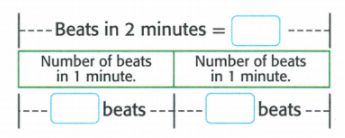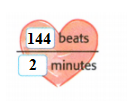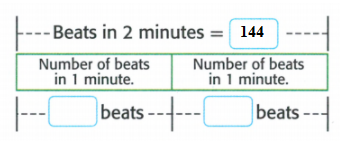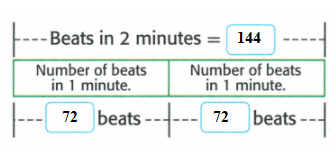Glencoe Math Course 2 Volume 1 Common Core Chapter 1 Ratios and Proportional Reasoning
Page 9 Exercise 1 Problem 1
Let the two ratios be a:b and c:d
If both the ratios are equal a:b = c:d
Then the given ratio is said to be in proportion.
And also, if the sets increase or decrease in the very same ratio, then the ratio is said to be in proportion.
In terms of objects, if the two objects are said to be in the very same shape but in different sizes.
For example: If the two objects are spheres, but one is smaller while the other one is larger.
Here, even though the sizes differ, the corresponding angles will be the same.
This makes their ratios be in proportion.
Hence, the two objects are proportional.
Two objects are said to be in proportion if they have the same shape, and same angles but in different sizes. This makes their ratios be in proportion.
Page 9 Exercise 2 Problem 2
Use the results obtained from exercise 1 to complete the given bar diagram.
Also, determine the number of beats per minute for your partner.
The given bar diagram is

From exercise 1

Thus, 144 beats per 2 minutes.
Thus, by completing the given bar diagram using the obtained information, we get

To find the number of beats per minute, write an equation using the bar diagram.
Let the beats per minute be x
Thus, we get
x + x = 144
2x = 144
x = \(\frac{144}{2}\)
x = 72
Therefore, 72 beats per minute.
The bar diagram will become

The completed bar diagram will be

The number of beats per minute for my partner is 72 beats.
Hence, my partner’s heart beats 72 times per minute.
Page 9 Exercise 3 Problem 3
We need to use the results from Exercise 1 to determine the number of beats for
\(\frac{1}{2}\) minute for your partner.
The results from exercise 1 will be

Thus, 144 beats per 2 minutes.
Thus, by writing an equation using the information, we get
2x = 144
x = \(\frac{144}{2}\)
x = 72
Thus, for one minute, the number of beats is 72.
Therefore, the number of beats for \(\frac{1}{2}\) minute will be
\(\frac{1}{2}\) × x = \(\frac{1}{2}\) × 72
= 36
Thus, for \(\frac{1}{2}\) minute, the number of beats will be 36
The number of beats for \(\frac{1}{2}\) minute for my partner is 36 beats.
Page 12 Exercise 2 Problem 4
Given that, after 3.5 hours, Pasha had traveled 217 miles.
If she travels at a constant speed, we need to determine how far will she travel after 4 hours.
Determining the unit rate at which she travels per hour, we get
Unitr rate \( = \frac{\text { Number of miles }}{\text { Number of hours }}\)
= \(\frac{217}{3.5}\)
= 62 miles per hour
Therefore, Pasha can travel 62 miles per hour.
Calculate the distance she traveled after 4 hours.
Multiply the unit rate by 4 hours, and we get
\( \frac{62\text { miles }}{1 \text { hours}}\) × 4 hours = 62 × 4 miles
= 248
Pasha will have traveled 248 miles after 4 hours.
Pasha will have traveled 248 miles after 4 hours.
Page 12 Exercise 3 Problem 5
We need to calculate the unit rate of 5 pounds for $2.49 and round it to the nearest hundredth if needed.
The unit rate is given by
Unite rate \( = \frac{\text { Amount in dollars }}{\text { Number of pounds }}\)
= \({2.48}{5}\)
= 0.498
\(\approx\) 0.50 dollars per pound
The unit rate of the given is $0.50 per pound.
Page 12 Exercise 4 Problem 6
For example
If we want to measure our heartbeat, we will first check for a person’s pulse.
We calculate the pulse corresponding to the number of minutes.
Usually, the heartbeat is measured as beats per minute.
Here, the number of beats and the minutes are two different quantities.
Therefore, the rate of the heartbeat is measured by the formula below
Unite rate of heartbeat \(=\frac{\text {Number of beats}}{\text { Number of minutes }}\)
We cannot measure something without comparing it with another quantity.
Thus, it is explained that the rate is a measure of one quantity per unit of another quantity.
Page 13 Exercise 2 Problem 7
Given that the number of customers is 6840 customers.
The number of days taken is 45 days.
We need to determine the unit rate of the given and round the unit rate obtained to the nearest hundredth if needed.
Given:
Number of customers = 6840
Number of days = 45
The unit rate is given by the formula
Unite rate = \(\frac{\text {Number of customers }}{\text { Number of days }}\)
= \(\frac{6840}{45}\)
= 152 customers per days
The unit rate of the given is 152 customers per day
Page 13 Exercise 4 Problem 8
Given that the number of dollars is 7.40 dollars.
The number of pounds is 5 pounds.
We need to determine the unit rate of the given and round the unit rate obtained to the nearest hundredth if needed.
Given:
A Number of dollars = 7.40
Number of pounds = 5
The unit rate is given by the formula
Unit rate = \(\frac{\text {Number of dollars }}{\text { Number of pounds }}\)
= \(\frac{7.40}{5}\)
= 1.48 dollars per pound
The unit rate of the given is 1.48 dollars per pound.
Page 13 Exercise 5 Problem 9
Given that the number of dollars for which the socks sold is 5.79 dollars.
The number of socks sold is 12 pairs of socks.
We need to determine the unit rate of the given and round the unit rate obtained to the nearest hundredth if needed.
Given:
A number of dollars = 5.79 dollars.
Number of pairs of socks = 12
The unit rate is given by the formula
Unite rate = \(\frac{\text {Amount in dollars }}{\text { Number of pair socks}}\)
= \(\frac{5.79}{12}\)
= 0.4825
\(\approx\) 0.48 dollars per pair of socks.
The unit rate of the given is 0.48 dollars per pair of socks.
Page 13 Exercise 6 Problem 10
The results of a swim meet are shown below

We need to determine who swam the fastest
The time taken for Tawni to swim per meter is
Unite rate = \(\frac{\text {Time taken }}{\text {Meters crossed }}\)
= \(\frac{40.8 \text { seconds }}{50 \text { meters }}\)
= 0.816 seconds/meter
The time taken for Pepita to swim per meter is
Unit rate = \(\frac{60.2}{100}\)
= 0.602 seconds/meter
The time taken for Susana to swim per meter is
Unit rate = \(\frac{112.4}{200}\)
= 0.562 seconds/meter
Among them all, the time taken for Susana to swim per meter is less compared to others.
Time is taken for
Tawni = 0.816 seconds/meter
Pepita = 0.602 seconds/meter
Susana = 0.562 seconds/meter
Thus, Susana is the fastest among them all.
Susana swam the fastest.
Page 13 Exercise 8 Problem 11
Given that, Kenji buys 3 yards of fabric for $7.47.
Then he realizes that he needs 2 more yards.
We need to determine how much will the extra fabric cost
The unit rate of the fabric is
Unite rate = \(\frac{\text {Amount in dollars }}{\text {Number of yard of fabric}}\)
= \(\frac{7.47}{3}\)
= 2.49 dollars per yard of fabric
He needs two more yards of fabric. The cost of two yards of fabric is
The cost of two yards of fabric is
2 yards of fabric \(\times \frac{2.49 \text { dollars }}{1 \text { yard of fabric }}\)
= 2 × 2.49 dollars
= 4.98 dollars
The cost of the extra fabric is 4.98 dollars.
